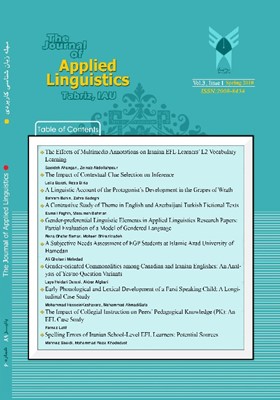Spelling Errors of Iranian School-Level EFL Learners: Potential Sources
الموضوعات : آموزش زبان انگلیسی
مهناز سعیدی
1
,
محمدرضا خدادوست
2
![]()
1 - Department of English Language, Tabriz Branch, Islamic Azad
University, Tabriz, Iran
2 - Department of English Language, Tabriz Branch, Islamic Azad
University, Tabriz, Iran
الکلمات المفتاحية: Sources of Errors, Interlingual, Intralingual, Unique Errors, English Spelling,
ملخص المقالة :
With the purpose of examining the sources of spelling errors of Iranian school level EFL learners, the present researchers analyzed the dictation samples of 51 Iranian senior and junior high school male and female students majoring at an Iranian school in Baku, Azerbaijan. The content analysis of the data revealed three main sources (intralingual, interlingual, and unique) with seven patterns of errors. The frequency of intralingual errors far outnumbers that of interlingual errors. Unique errors were even less. Therefore, in-service training programs may include some instruction on raising the teachers’ awareness of the different sources of errors to focus on during the teaching program.
Ahmadian, M. (1989). Pedagogical applications of contrastive analysis to teaching consonant clusters to Persian speakers. Unpublished master’s thesis. Tarbiat Modarres University, Tehran, Iran.
Caravolas, M. (2004). Spelling development in alphabetic writing systems: a cross-linguistic perspective. European Psychologist , 9(1), 3-14 .
Cook, V. J. (1997). L2 user and English spelling. Journal of Multilingual andMulticultural Development, 18(6), 474-488.
Corder, P. (1981). Error analysis and interlanguage. Oxford: Oxford University Press.
Corder, P. (1976). The study of interlanguage. In proceedings of the fourth international conference of applied linguistics. Munich, Hochschulverlag.
Corder, P. (1967). The significance of learners’errors. International Review of Applied Linguistics, 5,161-9.
Dulay, H., & Burt, M. (1974a). You can’t learn without goofing. In J.C. Richards (Ed.): Error Analysis ( pp 95-123. ). London: Longman.
Dulay, H., & Burt, M. (1974b). Errors and Strategies in Child Language Acquisition. TESOL Quarterly, 8,129-36.
Dulay, H., Burt, M., & Krashen, S. (1982). Language two. New York: Oxford University Press.
Ellis, R. (2008). The study of second language acquisition. Oxford: Oxford University Press.
Ellis, R. (1994). The study of second language acquisition. Oxford: Oxford University Press.
Ellis, R. (1985a). Undestanding second language acquisition. Oxford: Oxford University Press.
Fagerberg, I. (2006). English spelling in Swedish secondary school: Students’ attitudes and performance. Sweden: Karlstads University Press.
Feez, S. (2001). The role of dictation in teaching and learning English. Retrieved April 10, 2011 from http://www.telenex.hku.hk/ .
Ferroli, L. (1991). Developmental spelling and the transfer of literacy skill among primary grade bilinguals. (ERIC Document Reproduction Service No. ED362010).
Fisiak, J. (1981). Contrastive linguistics and the language teacher. Oxford: Pergamum Press Ltd.
Ghafar Samar, R. G., & Seyyed Rezaai, S. H. (2006). Analysis of errors made by Iranian English learners in their written production: A new answer to an old question?. Iranian Foreign Language Learning Journal, 80, 59-64.
Hanna , P. R. , Hanna , J. S. , Hodges , R. E. ,& Rudorf , E. H. ( 1966 ). Phoneme–grapheme correspondences as cues to spelling improvement. Washington, DC: U.S. Department of Health,Education, and Welfare.
James, C. (1981). Contrastive analysis. Essex: Longman.
Keshavarz, M. H., & Abdollahian, S. (2007). A cross-sectional study of composition errors committed by Iranian EFL learners. Iranian Foreign Language Teaching Journal, 82, 38-47.
Kessler, B. (2009).Statistical learning of conditional orthographic correspondence. Writing Systems Research. 1 (1), 19-34.
Kibbel, M. & Miles, T. R. (1994). Phonological errors in the spelling of taught dyslexic children. In C. Hulme, & M. Snoling (Eds.), Reading development and dyslexia (pp. 105-127). London: Whurr Publications.
Lado, R. (1957). Linguistics across cultures. Ann Arbor, Michigan: The University of Michigan Press.
Mirhassani, A., & Khodadust, M.R. (1998). The effect of error correction strategy on the pronunciation of Iranian high school learners. Iranian Foreign Language Teaching Journal, 49, 57-64.
Mirhassani, A. (1993). English and its spelling. Iranian Foreign Language Teaching Journal, 36, 35-42.
Mitchel, R., & Myles, F. (2004). Second language learning theories. New York: Oxford University Press.
Motevallian, R. (2009). The effect of pedagogical and linguistic factors in learning English spelling. Iranian Foreign Language Teaching Journal, 92, 4-10.
Mohammadi, M. (1992). English spelling rules and spelling errors analysis. Tehran: Navid Publications.
Nayyernia, A. (2011). Writing errors: what they can tell a teacher? Modern Journal of Applied Linguistics, 3, 200-218.
Odisho, E. Y. (1994). The alphabet and spelling connection: Insights from non-native learners of English. (ERIC Document Reproduction Service No. ED371604).
Oller, J. W. Jr. (1978). Language tests at school. London: Longman Group Limited.
Oller, J. W. Jr., & Ziahosseiny, M. (1970). The contrastive analysis hypothesis and the spelling errors. Language Learning. 20, 183-189.
Pavlenko, A., & Scott, J. (2002). Bidirectional transfer. Applied linguistics, 23( 2), 190-214.
Rashid, A., Lian, G. L., & Eliza W. R. (2003). An analysis of written errors in English. In LitCON conference proceedings entitled Literacy: Bridging past, present and future. P.48. Penang, Malaysia.
Richards, J. (1974). Error analysis: perspectives on second language learning. London: Longman.
Richards, J., Platt, J., & Platt, H. (1992). Longman dictionary of language teaching and applied Linguistics. London: Longman.
Rodriguez-Brown, F. (1987). Testing the transfer paradigm in second language learning:
The case of spelling skills. (ERIC Document Reproduction Service No. ED 336 965).
Shemesh, R., & Waller, S. (2000). Teaching English spelling: a practical guide. Cambridge: Cambridge University Press.
Tran-Chi-Chau. (1975). Error analysis, Contrastive analysis and students perceptions: a study of difficulty in second language learning. International Review of Applied Linguistics, 13,119-43.


